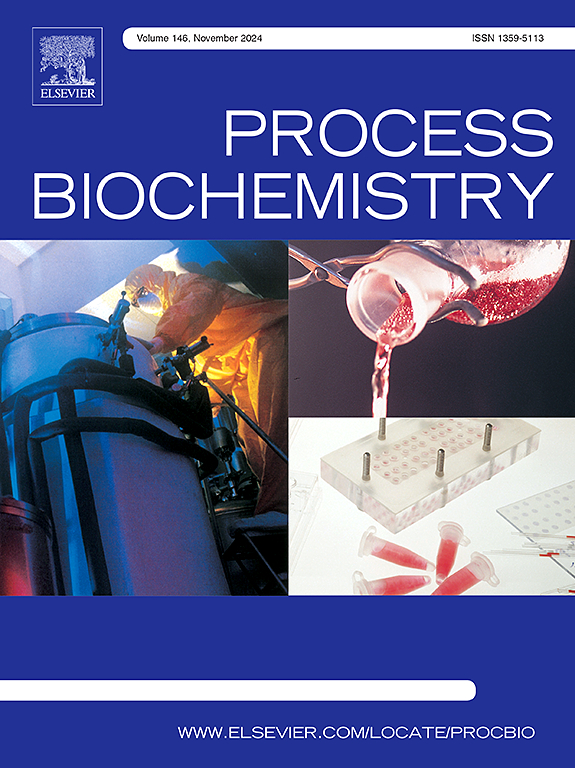Paenibacillus mucilaginosus-induced CO2 fixation into amorphous and crystalline carbonate minerals
IF 4
3区 生物学
Q2 BIOCHEMISTRY & MOLECULAR BIOLOGY
引用次数: 0
Abstract
Biomineralization offers a potential solution to CO2 fixation during oil exploitation. This study investigates the pathways of CO2 conversion and crystal nucleation mechanisms induced by Paenibacillus mucilaginosus ZH-28. At 16 % CO2 (v/v), Carbonic Anhydrase (CA) activity produced by ZH-28 reached 156.68 ng/mL, promoting mineral deposition of 6.55 mg/mL, indicating potential for in-situ carbon fixation. The study reveals that biological acids promote amorphous calcium carbonate (ACC) precipitation, while high calcium ion concentrations accelerate ACC conversion to crystalline calcite. The thermogravimetric results showed that during the gradual transformation of ACC into calcite, large numbers of free cells and organic matter around ACC were encapsulated by the calcite. Molecular dynamics simulations verified that CA catalyzes CO2 to HCO3- through a bicarbonate tetrahedral intermediate. The plugging potential of microbial-induced minerals was evaluated by microscopic displacement experiments and simulated core plugging experiment. Micro-morphological observations suggest that mineralization occurs via contact-mediated secondary nucleation, propagating in a zigzag pattern within 8–30 μm amorphous units. These findings provide insights into the transformation of amorphous materials into crystalline forms and offer new perspectives for CO2-microbial enhanced oil recovery (MEOR).
粘支芽孢杆菌诱导二氧化碳固定成无定形和结晶碳酸盐矿物
生物矿化为石油开采过程中二氧化碳的固定提供了一种潜在的解决方案。本研究探讨了粘胶芽孢杆菌ZH-28诱导CO2转化的途径和结晶成核机制。在CO2浓度为16 % (v/v)时,ZH-28产生的碳酐酶(CA)活性达到156.68 ng/mL,促进矿物沉积6.55 mg/mL,表明具有原位固碳的潜力。研究表明,生物酸促进了无定形碳酸钙(ACC)的沉淀,而高浓度的钙离子则加速了ACC向结晶方解石的转化。热重分析结果表明,在ACC逐渐向方解石转化的过程中,ACC周围有大量的游离细胞和有机物被方解石包裹。分子动力学模拟证实了CA通过碳酸氢盐四面体中间体催化CO2生成HCO3-。通过微观驱替实验和模拟岩心封堵实验,对微生物诱导矿物的封堵潜力进行了评价。显微形态学观察表明,矿化是通过接触介导的二次成核发生的,在8-30 μm的非晶单元内以锯齿形模式传播。这些发现为非晶材料向结晶形式的转变提供了新的见解,并为二氧化碳微生物提高采收率(MEOR)提供了新的视角。
本文章由计算机程序翻译,如有差异,请以英文原文为准。
求助全文
约1分钟内获得全文
求助全文
来源期刊

Process Biochemistry
生物-工程:化工
CiteScore
8.30
自引率
4.50%
发文量
374
审稿时长
53 days
期刊介绍:
Process Biochemistry is an application-orientated research journal devoted to reporting advances with originality and novelty, in the science and technology of the processes involving bioactive molecules and living organisms. These processes concern the production of useful metabolites or materials, or the removal of toxic compounds using tools and methods of current biology and engineering. Its main areas of interest include novel bioprocesses and enabling technologies (such as nanobiotechnology, tissue engineering, directed evolution, metabolic engineering, systems biology, and synthetic biology) applicable in food (nutraceutical), healthcare (medical, pharmaceutical, cosmetic), energy (biofuels), environmental, and biorefinery industries and their underlying biological and engineering principles.
 求助内容:
求助内容: 应助结果提醒方式:
应助结果提醒方式:


